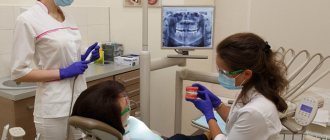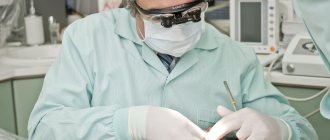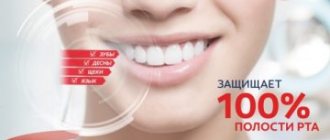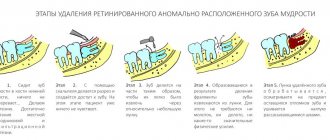27.11.2019
Patients often turn to dentists with malocclusions. To correct it, various methods are used, among which braces are especially popular. The question immediately arises: what is the name of the doctor who puts on braces? This is done by a specialist in a narrow field - an orthodontist, whose activities are very diverse.
Description of structures that can correct the bite
Aligners or mouthguards are structures made of heavy-duty materials.
Advantages of aligners:
- Possibility to remove the structure;
- Made from discreet transparent material;
- Minimal discomfort when wearing;
- There is no need for special care (except for normal hygiene and rinsing with water).
Trainers are structures that are worn for several hours a day, depending on doctor’s orders. They are produced in series, which makes them affordable. Designed to correct minor changes in bite. With their help, it is good to align teeth that are located separately from each other.
Braces are small brackets connected by a power arc. Such designs are capable of correcting a large number of different deviations.
Note: They are worn depending on the initial curvature of the teeth and the body’s adaptation to changes, from two months to five years.
Features of treatment for adults and children
Many parents make mistakes when they do not promptly treat malocclusion in children. Doctors say the earlier the correction begins, the more effective the result will be.
It is considered ideal to see an orthodontist for children as young as 2 years old. In this case, he will be able to identify possible congenital malocclusions already at the stage of growth of baby teeth (it is by this age that most of the dentition appears in children). At this age, correction is not done with braces, but with special aligners or mouth guards. Timely implementation of such a procedure helps to avoid many problems in the future.
For adult patients, doctors most often install permanent types of braces, mostly made of metal. They are considered the most durable and effective. When installing such structures, the patient often feels discomfort, so if necessary, the doctor can use anesthesia.
Which doctor puts on braces?
Patients often have a question: what is the name of a braces doctor? Bite anomalies are a field for the work of an orthodontist. Due to the rather narrow specialization of such a specialist, it is not always easy to find him.
The results of correcting the bite primarily depend on who puts the braces on, that is, on the qualifications of the doctor, as well as on the equipment of the dentistry where the treatment is carried out. If the doctor has correctly diagnosed and drawn up the correct correction plan, the patient can already count on successful treatment.
Some people are mistaken in believing that only young patients consult an orthodontist. After all, adults can also get braces. The only thing is that, due to the high density of dental tissue in adults, they will have to wear braces longer than children.
The need to tighten braces
When using this type of bite correction, the teeth move into the correct position. This is a rather long and painful process. The braces are secured using a special arch, which must be periodically tightened as the teeth move. This is also done by an orthodontist who installs the braces system.
How often to tighten the metal arch depends on the degree of curvature of the patient’s teeth and is determined individually. On average, this procedure is performed once every few months; a doctor called an orthodontist will help you determine the exact frequency of visits. This depends on the material from which the braces are made, the condition of the patient’s teeth and the total duration of the course of therapy.
It is not recommended to skip such visits, otherwise the effectiveness of braces will be significantly reduced. On average, correcting a bite takes 3 years or more, so you need to prepare for multiple visits to the doctor.
During braces tightening, a person may experience pain, and you need to be prepared for this. This process is associated with increased pressure on the teeth as they move. In some cases, doctors may prescribe local pain medications. If the arch is tightened incorrectly, discomfort may occur while talking or eating. In this case, you must inform the doctor who installed the braces.
Another prerequisite is oral care during treatment with such structures. It involves the use of special toothbrushes, toothpastes and mouth rinses. Your doctor will help you select the necessary medications; he will also explain how to brush your teeth while wearing braces.
Category Orthodontics Published by Mister stomatolog
Features of the orthodontist's work
When seeing a patient, the doctor needs to explain to him the purpose of wearing braces and how this will affect changes in the bite. On average, an orthodontist manages to see up to 13 people in one working day. One appointment takes approximately 30 minutes.
Treatment with braces takes place in 2 stages. At the first stage, the doctor makes a diagnosis and installs correction devices. At the next stage, it is secured by installing mouthguards or retainers on the inside of the teeth, which resist displacement of the bite.
For each situation, the doctor needs to choose the appropriate design. Braces differ in the method of fastening, the principle of influence and appearance.
Types of bites can be different. Let's consider the main ones:
- hereditary, passed on from parents to their children. Bite defects in this case are combined with the presence of additional teeth, diastema and trema. When diagnosing, there is a need for additional procedures;
- congenital, when disorders occurred already during the development of the fetus. Then, after birth and adulthood, dental defects or lack thereof are observed. This complex type of bite is a job for an experienced orthodontist;
- acquired, arising years after birth. It can be recognized at an early stage of its appearance, so treatment is more effective and does not take much time.
Today, an orthodontist in cities can be found in both private and city dentistry. Therefore, people with malocclusion can easily be helped by a qualified doctor who can correct defects and make their smile attractive.
An orthodontist who is popular among patients usually has human qualities in addition to professional ones. He is tolerant, sociable, efficient and friendly. Also, a good orthodontist must be a psychologist in some way. After all, many people have a negative attitude towards braces, the installation of which can cause them stress. A good doctor knows how to win over a client and help him as much as possible.
An orthodontist is not just a dentist, his work is designed to make teeth beautiful, without causing discomfort, and people happy and smiling.
How to straighten teeth without braces
With age, bone and connective tissue become more rigid and more difficult to move in the desired direction. Therefore, in an adult, bite restoration has a number of features.
Traditional orthodontic treatment is braces, but for various reasons it is not suitable for everyone. These may be individual contraindications of the patient, special requirements for appearance and diction.
An alternative way to straighten teeth is to use aligners (aligners) - orthodontic structures made of safe medical plastic, the wearing of which is invisible to others.
Surgical correction of the bite is less commonly used - this method is indicated in the most difficult cases (severe open bite, traumatic violation of symmetry, hereditary defects).
In consultation with an orthodontist, you will choose the method by which teeth will be straightened, based on the clinical picture, recommendations, and cost of treatment.
When should you see a doctor?
Let's consider the cases in which you need to see an orthodontist:
- If there are defects that spoil the aesthetic condition of the smile, the patient can voluntarily consult a doctor.
- In case of disorders of the dentofacial apparatus (for example, complications after prosthetics or tissue damage), a visit to the orthodontist is simply necessary.
- Formation of a deep bite.
- The lower jaw is positioned incorrectly.
- The presence of negative habits (speech deviations, the patient often sucks his finger, etc.).
- Curled teeth.
- Secondary malocclusion.
The services of an orthodontist can eliminate problems that interfere with prosthetics, or make it possible to avoid them.
An orthodontist also treats caries, periodontitis, periodontal disease and gingivitis.
Why do teeth grow crooked?
Often children inherit not the best traits of their parents. If parents have a similar problem, the anomaly is likely to be passed on to the child. In addition to genetic predisposition, the deformity is provoked by a lack of vitamins and microelements in the diet of the expectant mother. The lack of solid food in the baby's menu, frequent mouth breathing, congenital anomalies - all this affects the formation of the dentition.
One of the common causes of malocclusion is thumb sucking in childhood. At school age, the child switches to sucking pens, pencils, and begins to bite his nails. Injuries and poor oral hygiene can also cause crooked teeth. Early loss of baby teeth can lead to crooked permanent teeth.
Problems with wisdom teeth
Initially, the dentition may be straight. If your dentist notices that it has started to become crooked, wisdom teeth may be the cause. Third molars displace adjacent teeth. But even after their removal, the dentition will no longer straighten on its own.
Often the eruption of eights occurs at the age of 20-25. If they have nowhere to erupt, they move their neighbors who are located in front. If before the appearance of figure eights the dentition was straight, then after their appearance orthodontic treatment may be necessary.
At a consultation appointment in our clinic, the doctor will assess the condition of the oral cavity. If necessary, he will remove third molars under anesthesia. You will not feel pain or discomfort. If you're self-conscious about your smile, it's time to make an appointment with an orthodontist.
Need some advice?
Enter your phone number and we will give you a free consultation
I want a consultation
*By making an appointment you consent to the processing of your data
Loss of teeth
When removed, teeth tend to fill the void and take up free space. By bending and moving, they create the basis for the improper development of others. This causes crowding.
In this case, the permanent tooth, which no longer has a place where it should erupt, follows the path of least resistance. He takes a place that is convenient for him. The cause of abnormalities in adults is injury. Under the chewing load, the dentition constantly shifts towards an empty space. Even if your bite was perfect before, in this situation it will deteriorate.
Underdeveloped dental system
The distant ancestors of mankind had no problems with the dental system. This is because they ate solid food that was not thermally processed. Due to the fact that people now eat freeze-dried food, the dental system does not develop as it should. As a result, the number of teeth remains the same, and the jaws do not fully develop.
This leads to crowding and the development of malocclusions. A person should eat solid food from childhood. Prolonged sucking of pacifiers negatively affects the formation of the dentition system.
Stages of treatment by an orthodontist
At the beginning of treatment, the specialist conducts a diagnosis, which largely determines the final result.
The patient goes through the following stages:
- Visual inspection. The doctor studies the symmetry of the face, shape, profile and features of the oral cavity. An assessment is made of the general appearance of the teeth and jaws. The movement of the jaw and the closure of teeth are studied. The examination helps to identify how severely the bite is deformed and determine how difficult and long the treatment will be.
- An oral x-ray gives a general picture of the condition of the jaws and teeth. The image shows features that may not be noticed during normal examination.
- Making plaster models based on dental impressions taken. The model shows the location of the teeth, all the cusps and pits of the jaw. The specialist measures the necessary parameters and determines possible deviations. All features of the planned design must be taken into account at this stage.
Having determined the diagnosis, the specialist decides on a method to correct the problem:
- myotherapy - used only for small patients who are not allowed to have braces. Gymnastics of the jaws is carried out, during which children are given a correct bite that has not had time to form. The method cannot guarantee a 100% result. Gymnastics can also be used for adult patients when there are features that resist the use of other methods;
- hardware - used for patients of any age. For adults, the adjustment will take one to two years longer than for children. The procedure itself takes about an hour. The doctor installs braces, plates or aligners;
- surgical - used when there is no room in the mouth for teeth to grow or they are severely twisted.
Reiter
According to research from foreign institutes, malocclusion occurs very often among people all over the world and this situation needs to be changed somehow, which immediately forms a special area in medical clinics - rooms for correcting bites, which can be located at clinics and private medical centers.
1. How to correct bite in children and adults?
2. Types of braces, features and disadvantages.
3. Which doctor corrects dental occlusion and how to make an appointment with him?
Some sources claim that this figure reaches 80% of the population. But in the modern world this is no longer such a big problem as it used to be. Many technologies and modern materials make it possible to correct a bite in a child or adult painlessly and in a short time.
Some services can be obtained for free, while others require a fee. The orthodontist always offers his own prices and manages the entire process from the first time a person enters the dental office until the completion of the correction process.
A correct and beautiful smile is actually of great importance to a person. A smile is a person’s face, what we see first when starting any relationship, which is why it is necessary to correct any defects associated with a violation of the correct position of the teeth.
Why you need to make a beautiful smile and correct your bite:
- 1
. Your teeth must fully meet modern requirements and health regulations; - 2
. You must create a certain healthy outlook on your life; - 3
. The correct functioning of the jaws and teeth is formed, which ensures the physiological functions of the body; - 4
. Your appearance is transformed and you experience psychological pleasure from the way your teeth look.
Most not only personal, but also business relationships are difficult to establish if a person has complexes, avoids smiling and behaves awkwardly. Moreover, correcting a bite is now much easier than, for example, 10 years ago. A large number of public clinics have opened that offer inexpensive treatment, and you can also use the help of a private specialist who accepts in a commercial structure and gives the same guarantees as a municipal doctor.
In addition to the aesthetic problem, malocclusion also has practical aspects. Not only can it lead to gum inflammation, but it also has a negative effect on digestion in general. If malocclusion is noticed in children, then it is necessary to immediately begin to resolve this issue and contact specialists. Read reviews on various orthodontic portals, where many people post information, and you will learn a lot of useful information about this problem.
World practice allows you to correct your bite with the help of braces, mouth guards and special devices, which are offered not only in foreign countries, but also in our country. Today, there are many different technologies and methods for correcting malocclusion. One way or another, each method has its pros and cons. Separately, we can touch on the cost, which forms a complete picture of the treatment and its availability.
Correcting overbite with braces
Braces are considered the oldest and most proven method for effectively correcting malocclusion; they are used for both children and adults. The name itself translates as bracket or lock. And this is not surprising, because in fact, braces are similar to staples, and they are often called that.
This device itself looks like a set of brackets made in a laboratory, which are connected to each other by a special arc that holds them in the required position. Then these brackets are attached to the teeth themselves using special glue, and then, under the force of the arc, the dentition acquires the required location.
The advantage of braces is their versatility and ability to correct dental malocclusion without serious complications. They guarantee a non-removable technique of use, when fixation is carried out only once and there are no additional methods that would force the removal and installation of braces several times a year. With their help, it is possible to correct the bite and almost any violation of the position of the teeth.
Why can braces correct your bite?
- 1
. They create a certain force that is able to move the teeth into the correct position; - 2
. There is no difficult job for them that they cannot handle (with the exception of surgical situations); - 3
. Braces do not harm the teeth during correction and do not break the crown of the tooth, since they correct the bite gradually and with the formation of a “soft” load.
Braces are installed by a professional doctor, so no action or manipulation is required from the patient at all. An orthodontist will correct your bite with braces without using additional equipment and is only able to complete your treatment using this technique. This deserves attention and people often turn to dental clinics for such treatment.
The treatment process with braces lasts quite a long time, the required time ranges from 6 months to 2-3 years. During this time, the teeth take the required position, shape, and the patient acquires the long-awaited Hollywood smile. But braces are different, according to purpose, material and other criteria. The patient and the doctor decide on the type of braces to choose.
Plastic braces
This type of system is considered budgetary because it is relatively inexpensive. They appeared quite recently and immediately competed with classic metal braces. The advantages of plastic systems include the abundance of colors. Thanks to this, you can choose an original and unusual color for the system.
Due to this feature, such systems are often used in the treatment of children. Children perceive unusual colors of braces as a kind of game, and it is easier for parents and doctors to convince the child to get them. There is a unique opportunity to choose a special yellowish color for heavy smokers, thanks to this solution it will be possible to solve the issue of pigmentation of the material. Children are given braces to correct their bite only from a certain age, when the teeth are completely ready for orthodontic influence.
Metal
The first systems that appeared in medicine were made of metal. This is explained by the fact that there were no expensive and durable composite materials yet, and metal has always been valued due to its reliability. These braces are still considered the most durable and reliable; many highlight them as the most suitable way to correct a bite quickly and reliably. They helped treat malocclusions with great care and sat securely on the teeth, which helped them receive positive feedback from many grateful patients. We will classify external braces in a special section called “vestibular treatment of occlusion”, and for internal braces we will consider a section that can be called “lingual correction of dental occlusion”.
Metal braces are attached mainly to the outside of the teeth, but there are systems that are installed from the inside, and we have already mentioned them above. In general, this material and method of treatment has long proven its effectiveness. Here, special metal alloys are most often used, where each alloy is a special chemical group that may have its own positive qualities.
But any phenomenon has not only advantages, but also disadvantages. The disadvantages of metal braces include the aesthetic component. Today, they are the ugliest. It is especially difficult to convince children to install such a system, since they are particularly sensitive to problems of appearance. But, one way or another, if a child has problems with the position of his teeth, then it is necessary to take measures aimed at correcting the bite immediately. The sooner you see a doctor, the more effective the treatment will be and you can quickly return your teeth to their correct position.
Sapphire braces
Technology does not stand still in any field, and even more so in medicine and dentistry. The use of sapphire braces to restore bite can easily be called a modern and effective solution. It is aimed at making it possible to correct the bite not only qualitatively, but also aesthetically beautiful.
Such braces are made from special artificial sapphires, which in turn are an environmentally friendly material and are absolutely harmless to humans. Such systems not only help to completely correct the bite, but also look chic. They fit perfectly into the human dentition. You can be proud of such systems, and not, on the contrary, hide your smile and be embarrassed. We have already discussed this topic in detail and offered to read patient reviews and look at the prices of this method.
Such braces refract sunlight better than all other systems. Before installing them, all teeth are usually whitened so that the smile with the installed system looks just perfect. Sapphire is also a very corrosion-resistant material, so braces are not subject to discoloration. Throughout the entire time the color remains the same. The disadvantages of this system include their cost; this is the most expensive type of braces. With the help of sapphires, you can not only correct your bite, but also do it without losing aesthetics. But it will cost more than with any other technology.
In addition to braces, other technologies are also used, for example, mouthguards, surgical methods, laser technologies and other methods. Do not forget that technology in dentistry is constantly developing and very rapidly. Thanks to this, it is possible to choose a treatment method in each specific case. Only a doctor can advise you on which method to use.
Which doctor will correct the bite?
There are several specialists here, but the main importance is given to the orthodontist, who treats in an orthodontic way. A surgeon can also correct a bite, but the number of calls to this specialist is much less than to an orthodontist. Now the time has come when no one can limit you in your own choice of a medical clinic and you enter into a dental contract and receive treatment.
The orthodontist gives you the opportunity to choose treatment methods and begins his work. His work is based not only on constant monitoring of your bite, he also makes the necessary changes during the treatment process, and without this, the bite correction cannot be completed. Some people think that getting braces is a free time where you wear braces and don't see a doctor until the whole period is over, but that's not true! You should be monitored by a specialist and he should constantly monitor the movement of your teeth.
Let us correct your bite and trust your health to our orthodontists, who are in constant interaction with patients and treat a sufficient number of patients.











